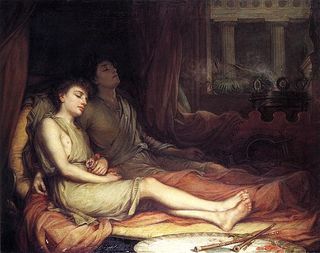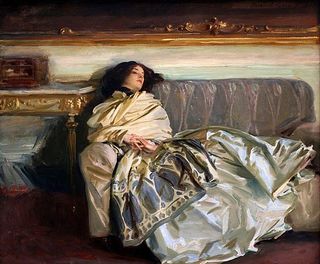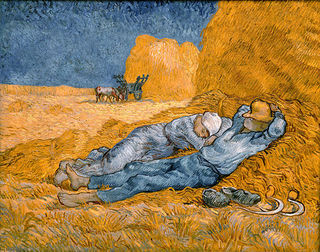Sleep
The Long and the Short of It: Sleep Duration and Health
What we know about the metabolic consequences of too little or too much sleep
Posted December 21, 2017

The so-called “Seven Sleepers of Ephesus” were Christian men who attempt to escape Roman persecution in the 3rd century AD by hiding in a cave. Their persecutors seal off the cave, but eventually, by chance, the entrance is opened, and these seven men emerge. When they send one of their group to obtain some food, he finds everything has changed, and Christian crosses now appear on buildings. What’s more, he realizes his coins are ancient and no longer in circulation. Apparently, so this apocryphal tale goes, according to Dutch professor of religion, Pieter W. van der Horst, the men had been sleeping in the cave for over 300 years. A version of their story, depicted in illuminated manuscripts and classical paintings, can be found in Greek, Jewish, Christian, and Muslim sources. (van der Horst, 2011)

Then there is the more familiar story of Rip Van Winkle, who is “one of those happy mortals, of foolish, well-oiled dispositions, who take the world easy...and would rather starve on a penny than work for a pound.” This does not suit his wife, “a terrible virago,” who has no tolerance for Rip’s lazy and careless disregard for her demands. One day, in an effort to have some brief respite from Dame Van Winkle, hen-pecked Rip goes walking with his dog and gun in the mountains of the Hudson Valley. What happens to him is not entirely clear, only that he meets up with some mountain characters that get him drunk. When he finally awakens, he finds his dog is no longer there, his beard has grown over a foot, and his gun is now rusted. And when Rip returns to his village, he recognizes no one, and no one initially recognizes him for it is some 20 years since he had disappeared.

In these fantastical tales, the so-called “long sleepers” have no idea how long they have been asleep, and we hear essentially nothing of the physiological effects of their long sleep on the body. Fictional accounts seem to be captivated by those who can awaken after a very long sleep without any dire consequences. Rip is apparently no worse for wear; the Seven Sleepers of Ephesus, though, do die shortly after they emerge from their cave.
What do we know about our need for sleep? Sleep occurs universally in all animals, and it is "infinitely more complex, profoundly more interesting, and alarmingly more health-relevant,” says UCLA Berkeley Professor Matthew Walker, in his new book Why We Sleep. The exact function of sleep remains “controversial” but researchers acknowledge that had sleep not been essential, over the years of evolution, there would have been “natural selection pressure” to eliminate it, particularly since all animals are more vulnerable to predators and external threats while asleep. (Ogilvie and Patel, Sleep Health, 2017.)
There are several theories about our human requirement for sleep, including that sleep allows an opportunity for synaptic pruning in our brain (e.g. to facilitate learning and memory consolidation) or allows for the clearance of neural waste products, as well as increases immune functioning. (Ogilvie and Patel, 2017) In other words, sleep is a homeostatic function that is important for health, and we have known for years from animal studies that complete sleep deprivation can lead to death within a few weeks. (Ogilvie and Patel, 2017) Ironically, in classical Greek mythology, Hypnos, the God of Sleep is the brother of Thanatos, Death, depicted in John William Waterhouse’s classic 19th century painting, “Sleep and his Half-Brother Death.”

How much sleep do we need? Researchers are beginning to appreciate there is a therapeutic window for the amount we require, i.e., too much or too little may be associated with poor health. Experts, though, cannot agree on that exact amount: Consensus from the American Academy of Sleep Medicine and the Sleep Research Society now recommends at least 7 hours for adults (Watson et al, Sleep, 2015); the National Sleep Foundation recommends 7 to 9 hours for adults (and not more than 10 hours), and 7-8 hours for those older than 65 (and not more than 9 hours.) (Hirshkowitz et al, Sleep Health, 2015) There is, though, a growing concern that a huge percentage—almost 1/3, at least by self-report, are getting 6 or fewer hours a night (Ford et al, Sleep, 2015), often due to our 24/7 increased use of artificial lighting (e.g. television, smart phones, and computer screens) and longer working hours. Furthermore, as we tend to sleep less, obesity rates have doubled among adults and tripled among children and adolescents over the past thirty or so years, and many researchers question whether there may be some connection. (Capers et al, Obesity Reviews, 2015)
In their comprehensive and now classic review, Allison and over 20 of his colleagues (McAllister et al, Critical Reviews in Food Science and Nutrition, 2009) explain that reasons for this increase in obesity prevalence are “incompletely understood,” but they do include sleep debt as one of their ten “putative contributors.” Before World War I, Americans reportedly averaged up to 9 hours a night. Evidence from animal and human studies suggests that sleep deprivation “is consistently associated” with “profound effects” on levels of hormones (e.g. leptin, ghrelin) and peptides (e.g. galanin) that result in increased food intake, and in turn, potentially lead to an increased risk of diabetes, heart disease, increased body mass index, and even increased mortality. (McAllister et al, 2009) Further, fatigue due to sleep deprivation may lead to decreased activity and subsequent weight gain.
Allison and his colleagues (Davis et al, Obesity, 2018) revisit the topic of contributors to the obesity epidemic in their just-published discussion; they note the importance of considering "complementary hypotheses" and a "multi-factorial approach," including the "behavioral factor" of sleep deprivation. Sleep debt, incidentally, may have an even greater effect on body weight in children and adolescents. (McAllister et al, 2009)
Studying sleep duration in children is complicated because children have different sleep needs as they get older. Recommendations from the National Sleep Foundation (Hirshkowitz et al, 2015) include 10-13 hours for preschoolers; 9-12 hours for school-aged children; and 8-10 hours for adolescents. Li et al (Journal of Paediatrics and Child Health, 2017) found a 45% increased risk of obesity in those who are considered “short sleepers” in their review of studies, including over 44,000 children from the U.S., Canada, Australia, and the UK. Most studies relied on self-report (or parent report) questionnaires or diaries to assess the duration of sleep. Questionnaires, often not even validated, rely on retrospective recall and may be less accurate than sleep diaries that are filled out nightly. (Tan et al, Sleep Medicine Reviews, 2017) Both methods may be significantly less accurate than objective measurement of sleep duration by actigraphy, which is rarely used in studies.
One study of over 380 male and female adolescents found a dose-response relationship: for every hour of sleep reduction, there was an 80% increase in obesity. (Gupta et al, American Journal of Human Biology, 2002) “Overall, the published literature supports the presence of an association between sleep duration and weight” but there were considerable differences in the definition of "normal" and "short sleep" duration. (Patel and Hu, Obesity, 2008) "So that a six year old with 9 hours of sleep could be classified as having short, intermediate, or even long sleep duration, depending on the study." (Patel and Hu, 2008)

While many large epidemiological studies have found a significant relationship between short sleep and obesity, Allison and his colleagues (Capers et al, 2015) note that an actual “causal pathway” is far from clear, particularly because of differences in patient populations, small sample sizes, study design, and studies that are short-term. In their meta-analysis of 16 randomized controlled trials involving the relationship between sleep duration and body composition and energy balance, for example, they had to adjust their inclusion criteria (from a duration of at least four weeks to those that lasted only at least 24 hours) because only two studies had met that initial criterion. (Capers et al, 2015)
More recently, Itani et al (Sleep Medicine, 2017) reported on 153 prospective cohort studies in their systematic review and meta-analysis to assess the relationship between short sleep and multiple health data of over 5,100,000 people. The definition of “short sleep” varies with cultures and ethnicity. Another confusion is that some of their studies list “hours per day” and some list “hours per night.” They found, though, that short sleep (defined by fewer than 6 hours) was associated with increases in mortality, diabetes, hypertension, cardiovascular disease, and obesity, but these researchers, too, noted the mechanisms for these increases “do not seem straightforward.” Furthermore, they emphasize the need for caution from these community studies since “there is no rigorous evidence that lengthening sleep duration can lead to smaller frequency of these outcomes,” and the role of individual differences in sleep duration “is still uncertain.”

In addition, many studies don’t ask about napping during the daytime and so may underestimate total 24-hour sleep duration. The relationship of napping to sleep debt warrants further investigation. (Faraut et al, Sleep Medicine Reviews, 2017) There may also be large night-to-night variability (including differences between weekday and weekend sleeping duration.) Researchers also question the possibility of reverse causation, i.e., obesity can increase the risk of medical conditions such as osteoarthritis, GI reflux, asthma, and heart failure as well as obstructive sleep apnea, all of which can affect sleep duration. And there may be residual confounding, such as when psychiatric disorders such as depression, or use of medications, can affect both sleep and weight bidirectionally. (Krittanawong et al, European Heart Journal Acute Cardiovascular Care, 2017; Patel and Hu, Obesity, 2008)
"Long sleepers," often defined as greater than 9 hours a day, are also at risk for obesity and diabetes, at least from a review of observational studies. (Tan et al, Sleep Medicine Reviews, 2017) These researchers, though, note differences in results among studies, including how “long sleep” is defined. (Tan et al, 2017) They further wondered whether some long sleepers are more apt to use medication because they have a poor quality of sleep and may also have a more sedentary lifestyle, be less likely to exercise, and make unhealthy diet choices, as well as have a habitually later bedtime, i.e. what has been called an unhealthy “nocturnal lifestyle.” (Knutson et al, Sleep, 2017)

Bottom line: Since sleep deprivation has become so common in recent years, any causal association between short sleep duration and obesity would have substantial public health ramifications. (Patel and Hu, 2008) Though we cannot prove causality, (and we must consider the possibility of reverse causation, namely that obesity and its related disorders lead to changes in sleep duration), research suggests there are strong associations between the amount of sleep we get each night and metabolic health. Too much or too little sleep has each been linked to an increased risk of obesity, type 2 diabetes, hypertension, cardiovascular disease, and even increased mortality in adults and increased obesity in children and adolescents. Proposed mechanisms include increased hunger due to changes in hormone and peptide levels; additional time for increased food intake; increased pleasure from food, i.e., an “up-regulation” of food’s salience and reward value (St-Onge, Obesity Reviews, 2017); decreased physical activity due to fatigue; altered thermoregulation due to circadian rhythm misalignment; and even neuro-cognitive changes that lead to impaired judgment and decision-making regarding food choices. (St-Onge et al, Circulation, 2016)




